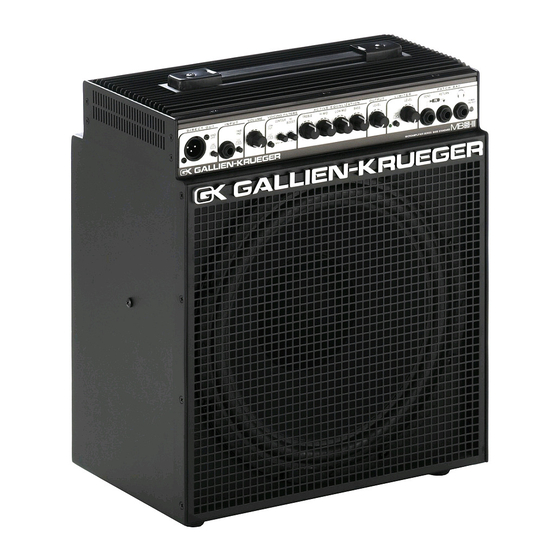- ページ 10
アンプ Gallien-Krueger MB150S-112IIIのPDF オーナーズマニュアルをオンラインで閲覧またはダウンロードできます。Gallien-Krueger MB150S-112III 12 ページ。 Gallien-krueger mb150e/112: user guide

- 1. Owner's Manual
- 2. Warranty Card
- 3. Safety Instructions Sheet
- 4. Table of Contents
- 5. Power Cord
- 6. Safety Information
- 7. GK Philosophy
- 8. Setup & Quickstart
- 9. Front Panel Controls
- 10. Internal/External Speakers
- 11. Rear Panel Controls
- 12. Sample Settings
- 13. Sound Advice
- 14. Tech Talk
- 15. Specifications
Tech Talk
MB Series Overview:
The MB Series is a flexible, state-of-the-art bass
amplifier, designed to deliver maximum performance,
and be simple to operate. This is accomplished
through a few, very important features:
·
·
High current capability for better speaker
control.
·
·
Four bands of active equalization for precise
tone control.
·
·
Robust voicing filters for shaping and cus-
tomizing your sound.
·
·
A high headroom gain stage for low noise
operation.
·
·
GK's proprietary Valve Effect for extra
growl
· ·
·
Class "H" design for better efficiency.
·
Intelligent protection circuitry which con-
stantly monitors for unsafe conditions.
High Current Capability:
When a power amplifier is pushing a speaker cone
and it needs to reproduce a high-power transient
like a string slap, the amp must be able to deliver a
high current pulse to maintain cone control. If the
amplifier can't do this it simply cuts the transient
off, producing an unresponsive less out front sound.
Creating these high current pulses requires extra
power devices (four times the current required to
deliver its rated power), larger supply capacitors,
and intelligent protection logic. GK is the only
bass amp manufacturer that goes to the trouble and
expense to make this happen and it is a big reason
why GK amplifiers sound louder and cleaner than
other brands at the same power rating.
Active Equalization:
Standard tone controls and graphic equalizers give
you plenty of variation, but they don't provide what
the instrument really needs. In fact, graphic equal-
izers are intended for room equalization and make
poor instrument equalizers. The GK equalizer
reflects 30 years of development and refinement
and is unique to the industry. Each section is a
special circuit optimized to perform a Bass specific
job in its operation range. These sections are wired
in series so they add to one another without creating
unmusical peaks or valleys. The result is an equal-
izer that is easy to use and sounds natural at any
setting.
MicroBass-III Series
Voicing Filters:
Voicing filters are used to completely re-voice the
amplifier in ways that an equalizer cannot. They
are extreme filters enabling the amplifier to ac-
commodate a wide variety of playing styles with
the simplest adjustments.
·
·
The Contour is based on the same contour
circuit as the 800RB, but adds a variable
control for precise tone shaping. With the
control at zero, it matches the 800RB con-
tour switch 'out' or off, and when turned
all the way up, it matches the 800RB
contour on. As the contour is increased, it
scoops out the mid frequencies while em-
phasizing the lows and highs. Additionally
it compensates to keep the overall playing
volume constant. With it's variable con-
trol, the contour will accommodate every-
thing from the smooth finger-style player
(set flat or off), to the aggressive slap
player (fully scooped).
·
·
The Low Cut filter rolls off the low end
early in the signal path (before the EQ)
which works well for four string players
going for a heavy rock stage sound where
too much bass interferes with the room.
·
·
The Presence control adds extra sparkle on
the high-end for better clarity and 'open-
ness' in your tone. This is particularly
useful when soloing or playing chords.
Limiter:
When the upper level of an amplifier's usable dy-
namic range is exceeded, audible signal distortion
will occur which can damage speakers. Reducing
the volume would create more headroom, but also
increases the signal to noise ratio. It is therefore
necessary to keep the volume level as high as pos-
sible. This is accomplished by using a limiter. A
limiter sets a ceiling called the 'threshold', which
restricts peak signals from exceeding the threshold
point, allowing you to play at a higher overall vol-
ume level with less noise and less risk of distortion.
While more limiting means increased headroom, it
can also rob the dynamic range from your signal.
Be careful not to overdo it.
10
